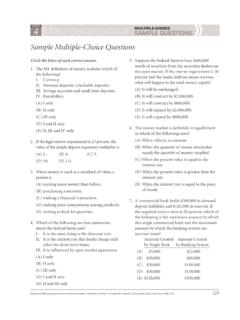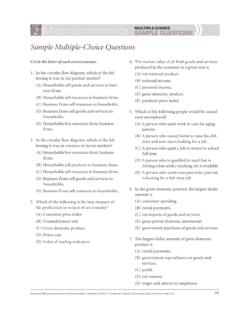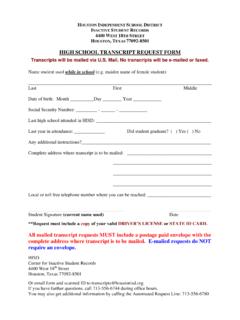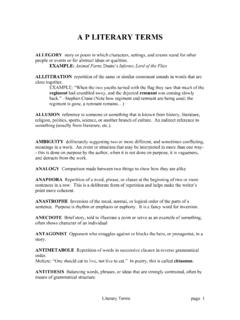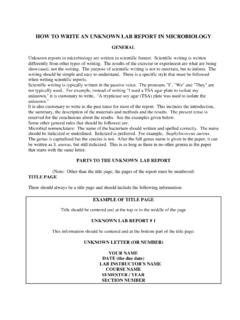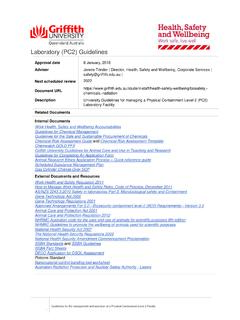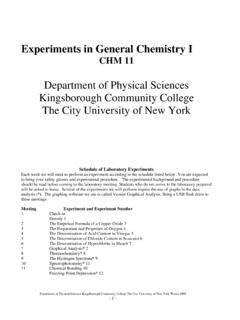Transcription of Student Reference - Houston Independent School District
1 IntroductIon to AutomotIve technology Automotive TechnologyModule 1: Introduction to Automotive TechnologyStudent ReferenceProduced by the Instructional Materials Laboratory1400 Rock Quarry CenterUniversity of Missouri-ColumbiaColumbia, MO 65211(800) 669-24652006 EditionCatalog no. 70-1801-S 2006. The Curators of the University of Rights :Ken EstesRobin FergusonSteve ReeseProjectCoordinator:Erica KasselEditor:Janis LevsenGraphic Artists:Chris BenedictJacqueline CraigAutomotIve technology IntroductIon to AutomotIve technology ACKNOWLEDGMENTSThe 2006 revision of Introduction to Automotive Technology represents the Instructional Materials laboratory s commitment to the continual improvement of the Automotive Technology Curriculum. Introduction to Automotive Technology is the first in the nine-module series.
2 The other modules are as follows:Module 2 Electrical SystemsModule 3 Engine Performance, Section 1: Ignition SystemsModule 3 Engine Performance, Section 2: Fuel and Exhaust SystemsModule 3 Engine Performance, Section 3: Emission Control SystemsModule 4 Engine RepairModule 5 Steering and Suspension SystemsModule 6 BrakesModule 7 manual Drive Train and AxlesModule 8 Automatic Transmissions and TransaxlesModule 9 Heating and Air ConditioningAll modules are based on the National Automotive Technicians Education Foundation (NATEF) task list. For years the National Institute for Automotive Service Excellence (ASE) has set the professional standards for automotive technicians. A strong NATEF orientation makes the nine curriculum guides an effective tool for preparing students to enter the technologically advanced field of automotive gratefully acknowledges the important contribution of the advisorycommittee:Roger Donovan, Illinois Central College, East Peoria, ILKen Estes, Grand River Technical School , Chillicothe, MORobin Ferguson, Kirksville Vocational Technical School , Kirksville, MOSam Jeanrenaud, Lee s Summit, MOKeith Kendrick, John A.
3 Logan College, Carterville, ILSteve Reese, Lewis and Clark Vocational Technical School , St. Charles, MORon Tuetken, Lewis and Clark Community College, Godfrey, ILJohn Walker, Hannibal Area Vocational Technical School , Hannibal, MORodney Wolken, Eldon Career Center, Eldon, MOAutomotIve technology vIntroductIon to AutomotIve technologyvTABLE OF CONTENTSI ntroduction ..i Title Page ..i Acknowledgments ..iii Components ..vii References ..viiiUnit I Careers in the Automotive Field ..S 1 Lesson 1: The Automotive Technology Career ..S 5 Unit II Safety ..S 11 Lesson 1: Protecting Yourself and Others in the Shop ..S 15 Lesson 2: Shop Safety Features and Emergency Procedures ..S 35 Lesson 3: Raising and Supporting Vehicles Safely ..S 41 Lesson 4: Federal and State Hazardous Material Regulations.
4 S 49 Unit III Chemicals and Their Use ..S 59 Lesson 1: Solvents, Soaps, and Cleaning Solutions ..S 63 Lesson 2: Lubricants and Specialty Chemicals ..S 71 Lesson 3: Gases, Asbestos Dust, and Battery Acid ..S 79 Unit IV Basic Hand Tools ..S 85 Lesson 1: Types of Wrenches ..S 89 Lesson 2: Types of Screwdrivers and Pliers ..S 97 Lesson 3: Types of Hammers, Punches, and Chisels ..S 103 AutomotIve technologyv Unit V Specialty Tools, Fasteners, and Measuring Tools ..S 107 Lesson 1: Specialty Tools ..S 111 Lesson 2: Fasteners ..S 119 Lesson 3: Measuring Tools ..S 129 Unit VI Power Tools and Shop Equipment ..S 135 Lesson 1: Power Tools ..S 139 Lesson 2: Shop Equipment ..S 151 Unit VII Vehicle Information ..S 161 Lesson 1: Service Information and Vehicle Identification ..S 165 Unit VIII Customer Service.
5 S 169 Lesson 1: Customer Service, Work Orders, and Vehicle Preparation ..S 173 IntroductIon to AutomotIve technologyv COMPONENTSI. Objectives Each unit is based on objectives that state the measurable unit and specific behavioral or performance objectives that the Student is expected to achieve. Because the objectives of the unit provide direction for the teaching-learning process, the teacher and Student need a common understanding of the intent of the Information Sheets Presented in outline format, the information sheets provide content essential for meeting the cognitive (knowledge) objectives in the unit. The Student should study the information sheets before any class discussion or completion of the assignment sheets. The corresponding Student Reference page numbers appear in the upper corner of the Instructor Guide.
6 III. Assignment Sheets The assignment sheets allow the Student to respond to cognitive questions in writing. IV. Job Sheets The job sheets are designed to guide the Student through various key tasks and provide a means for the instructor to evaluate a Student s performance of the task. V. Unit Tests The unit tests evaluate the Student s knowledge of the Student Workbook and Student Test Packet Tracking Sheets These provide the instructor with an effective way to track Student progress on the assignment sheets, job sheets, and unit technologyv rEFErENCESA lliance of Automobile Manufacturers. Aqueous Parts Cleaning. Best Environmental Practices for Auto Repair, November 1999. Environmental Protection Lift Institute. Battery Safety. National Ag Safety Database (NASD).
7 , James E. Modern Automotive Technology. Tinley Park, IL: The Goodheart-Willcox Company, Inc., 2000. Floor Cleanup. Best Environmental Practices for Auto Repair, November 1999. Environmental Protection Motor Company. Motors. Automotive Technicians Education Foundation (NATEF). Institute for Automotive Service Excellence (ASE). Outlook Handbook, 2006 07 edition . United States Department of Labor. Bureau of Labor Statistics. Drive Systems. , Ed. Trends and Traits of Today s Technicians: The 2001 Professional Automotive Technicians Survey. Underhood Service, March , William K, Larry Johnson, and W. Scott Gauthier. AutomotiveEncyclopedia. Tinley Park, IL: The Goodheart-Willcox Company, Inc., States Department of Labor, Occupational Safety and Health Administration.
8 States Environmental Protection Agency. to AutomotIve technologyS UNIT I: CArEErS IN ThE AUTOMOTIvE FIELDCONTENTS OF ThIS UNITI. Unit objectiveII. Lesson plan A. Lesson 1: The Automotive Technology Career 1. Information outline 2. Assignment Sheet a. AS1-L1-UI: Automotive Technology FieldIII. Unit I TestAutomotIve technologyS IntroductIon to AutomotIve technologyS UNIT I: CArEErS IN ThE AUTOMOTIvE FIELDA fter completing this unit, students will be able to identify some of the opportunities in the automotive field and various facts about the automotive technology career. students will demonstrate mastery of the material by completing the assignment sheet and achieving a score of _____ on the Unit I OBJECTIvESAfter completing the lesson in this unit, students should be able to:Lesson 1I.
9 Identify some of the opportunities in the automotive Identify the importance of training and how automotive technicians and training programs are Identify job prospects in the automotive technology Identify common methods used to pay automotive Identify other facts about working as an automotive Complete the assignment sheet on the automotive technology field (AS1-L1-UI).AutomotIve technologyS IntroductIon to AutomotIve technologyS UNIT I: CArEErS IN ThE AUTOMOTIvE FIELDLESSON 1: ThE AUTOMOTIvE TEChNOLOGy CArEErI. Opportunities in the automotive field A. According to statistics from the Department of Labor, over 800,000 people in the United States are employed as automotive service technicians and mechanics. 1. Most are employed in the following businesses: a.
10 Automotive repair and maintenance shops b. Automobile dealers c. Retailers and wholesalers of automotive parts, accessories, and supplies 2. Others work in the following businesses or organizations: a. Gas stations b. Home and automotive supply stores c. Automotive equipment rental and leasing companies d. Federal, state, and local governments 3. Over 16% own their own their own business. B. Many job opportunities are available that relate directly and indirectly to the automotive technology field. AutomotIve technologyS 1. Opportunities directly related to automotive technology a. Automotive technician b. Automotive technician s apprentice c. Repair shop supervisor d. Exhaust and emissions technician e. Tune-up technician f. Service writer g. Mechanical unit repairer h.
